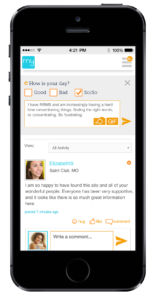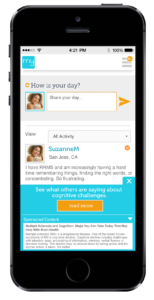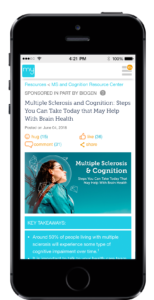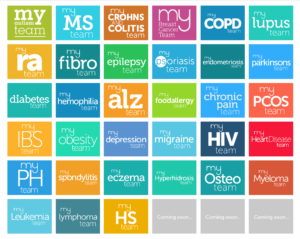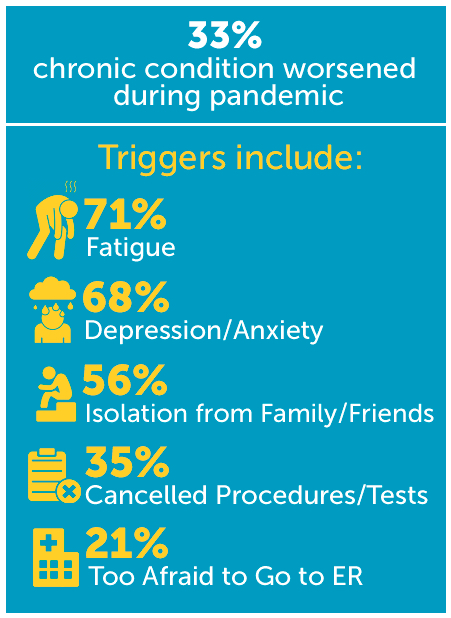
For the six in 10 Americans living with a chronic health condition, the COVID-19 pandemic took an especially difficult toll. 69% of people living with chronic disease report the pandemic has made it more difficult to manage their condition, and one in three say the symptoms of their condition worsened during the pandemic. Just as they were beginning to venture back out to in-person appointments with their doctors and to pre-pandemic exercise regimens and social engagements – the Delta variant swept in and put a damper on returning to life as normal.
(Image courtesy of MyHealthTeams)
There is a huge opportunity to engage and help patients with chronic conditions right now by giving them the content and information they need and want, in the setting where they feel safe and comfortable. Follow these six strategies to get an unfair advantage in engaging patients in Q4 and 2022 (all while feeling good knowing you are helping patients).
1. Answer the questions they have – not the questions you want them to have
On the surface this may sound obvious, but it’s amazing how often the healthcare system and pharmaceutical companies fail to address the most important, pressing questions on the minds of the patients they are trying to reach. Case in point – COVID vaccine recommendations. Exactly nobody with Crohn’s disease, or Multiple Sclerosis, or leukemia, or multiple myeloma were comfortable following the CDC’s general guidance about getting the COVID vaccine. They wanted to know whether it was safe for them, given their diagnosis, and their current medication (often an immunosuppressant). If you spend all your time marketing to people with leukemia, then get in their heads. Understand the pressing questions and figure out a way to get them to content that has trusted answers. Doing so will show that
you are on their side and interested in helping them achieve better outcomes – not to mention catch their eye, get them to stop what they are doing, and engage with the content you are sponsoring.
2. Bring the experts to the masses
The number of people utilizing telehealth services surged during the pandemic, and while that is a good thing, it is still one patient at a time and reliant on everyone having access to good specialists via telehealth. But now is a great time to bring the specialist, leading experts in a disease, to the masses. Not every patient with vitiligo has access to a dermatologist involved in clinical trials and research in that condition, for instance. So why not do a Live Q&A with the vitiligo expert and make it available to thousands of people with vitiligo (or whatever condition you are serving)? In one hour or less, a doctor can address about 10 hot topics that are top of mind for thousands of people facing the same disease and grappling with similar day-to-day challenges. And for those who can’t make the live event you can always record it for later viewing. Here’s the thing – hospitals don’t typically do this. Insurance companies don’t typically do this. Pharma companies absolutely should do this to engage patients – just make sure you do it with a partner, in a way that is at arms-length, so you don’t have to spend half of your life in MLR review.
3. Empower patients with virtual rehab sessions
Sheltering in place for months on end drove many people living with a chronic condition to try ondemand, at-home opportunities to care for their health – and it worked. The Home Rehab Network, for example, created virtual pulmonary rehabilitation sessions for COPD patients when the pandemic stopped all in-person sessions with respiratory patients. Short, two-minute video tutorials proved especially effective, with 71% of patients who regularly practiced the techniques reporting improvement in their shortness of breath. The content was engaging. Two-thirds of those who tried the techniques made them a daily habit. This type of approach opens up opportunities across many chronic conditions, serving patients who are seeking tips for how to incorporate simple condition-specific rehab exercises into their daily routines.

4. Think beyond the pill to serve the whole person
When surveyed, chronic condition patients consistently point to two factors that most influence their satisfaction with doctors: “Listens to me and understands me” and “Spends enough time with me.” In most cases, what they’re really seeking is recognition and practical advice for some of the things they are facing due to their chronic condition such as stress, anxiety, sexual dysfunction, bladder issues, sleeping issues – or – tips on how to eat healthy and workout safely while living with their specific disease. Filling this gap is a valuable patient engagement opportunity. Resources such as condition-specific nutrition recommendations, recipes and shopping guides, and even destigmatizing topics around mental or sexual health for example, can go a long way toward serving the whole person.
5. Foster strong social connections
There’s a growing body of evidence that strong social connections improve health outcomes. Finding ways to foster communication among people who share the same chronic disease diagnosis helps them share their unfiltered truth – firsthand experiences with treatments and side effects, practical tips for navigating challenges at work or home, emotional support for getting through the tough days, guidance for questions to ask at the next doctor’s appointment. This can happen through traditional patient support groups, of course. But in today’s digitally-driven world, it increasingly happens online – especially in condition-specific patient social networks.
6. Prioritize direct relationships with diagnosed patients
For marketers tasked with reaching diagnosed patients, it’s more important than ever before to prioritize audience quality when evaluating media partners. As Google phases out third-party cookies in a couple of years, these partnerships will be key to reaching and engaging target consumers. First-party data will be king, and the time is now to start building those trusted relationships. Connecting with patients when and where they are actively discussing and seeking information about their health will be essential to patient engagement success in 2022 and beyond.
Ultimately, following these strategies will not only get you strong results, they will also help improve health outcomes by empowering people to make informed health decisions and take the actions that are right for them.



